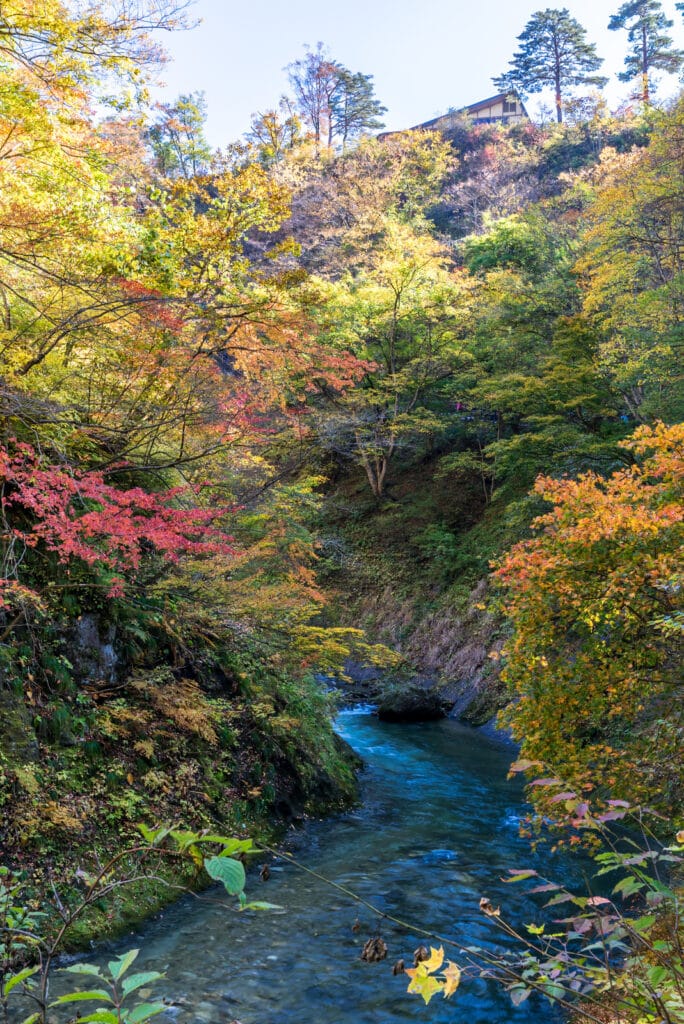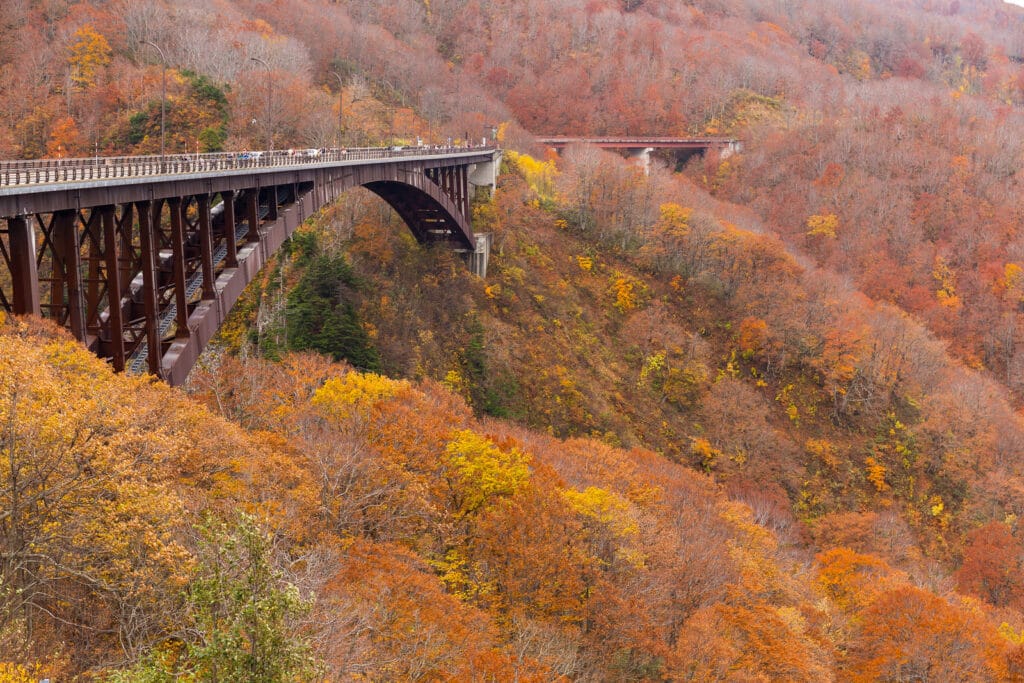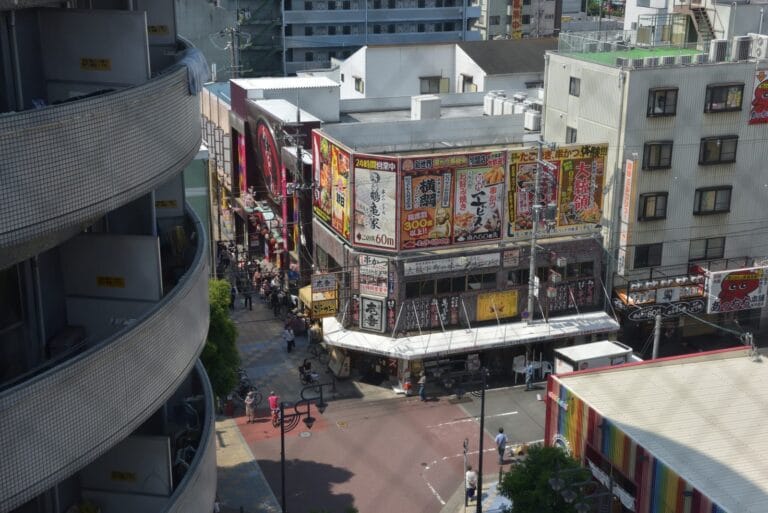I’ve explored Tohoku’s most magnificent natural wonders, and these 11 spots will take your breath away.
From Lake Towada’s crystal-clear waters and the ancient Shirakami Sanchi beech forests to the dramatic cliffs of Naruko and Geibikei gorges, nature’s grandeur is on full display.
You can’t miss Mount Hakkoda’s “snow monsters” in winter, the thundering Akiu Falls, or the rugged Sanriku Coast with its stunning ria formations.
The Twelve Lakes showcase mysterious blue waters, while Hachimantai Mountains offer year-round adventures.
Let me share the secrets of these remarkable destinations that’ll transform your northern Japan journey.
1) Lake Towada and Oirase Stream
Deep within the heart of Tohoku lies Lake Towada, Japan’s largest crater lake on Honshū island, straddling the border between Aomori and Akita prefectures.
At 400 meters above sea level, this natural wonder plunges to an impressive depth of 327 meters, making it Japan’s third deepest lake.
Much like the diverse Chubu landscape that stretches across central Japan, Lake Towada offers stunning geographical features shaped by volcanic activity.
While Kyushu boasts natural hot springs, Lake Towada’s pristine waters remain cool and crystal clear year-round.
I’ll let you in on the lake’s crowning jewel – the stunning Oirase Stream, its sole outlet that winds through a picturesque gorge for 14 kilometers.
You’ll want to tackle the 9-kilometer hiking trail, where you can marvel at a series of dramatic waterfalls and rapids.
If you’re timing your visit, I’d recommend late October through early November, when the autumn foliage transforms the landscape into a breathtaking canvas of reds and golds.
2) Shirakami Sanchi Beech Forests
Ancient beech trees stretch across 130,000 hectares of pristine wilderness in the Shirakami Sanchi region, straddling Aomori and Akita prefectures.
As one of the world’s largest virgin beech forests, it’s earned its place as a UNESCO World Heritage site, and I can’t think of a more deserving natural treasure.
Much like the seasonal festivals of Kyoto, the forest’s appearance transforms dramatically throughout the year.
When you visit, you’ll discover why these forests are so special:
- 400-year-old beech giants tower in Dakedai Forest
- Natural springs filter through ancient root systems
- Black bears and serows roam freely among 35 mammal species
- Rare plants like Aomori catchfly bloom in hidden corners
I recommend taking a guided trek through Tomeyama Forest – it’s perfect for beginners with its wooden boardwalks and rest areas.
At 4,000 yen, it’s a small price to experience this untouched wilderness that’s remained pristine since the last Ice Age.
The region’s pristine environment has helped preserve traditional food culture that relies heavily on mountain vegetables and wild herbs gathered from these forests.
3) Naruko Gorge

The dramatic cliffs of Naruko Gorge slice through northwestern Miyagi Prefecture, creating one of Tohoku’s most striking natural wonders.
Much like the hiking trails of Chugoku, the gorge offers breathtaking vistas year-round for nature enthusiasts.
I’d recommend visiting in late October when the 100-meter cliffs burst into a spectacular display of autumn colors, with maples and oaks painting the landscape in crimson and gold.
You’ll find the gorge easily accessible from Naruko Onsen Station, where you can catch a seasonal shuttle bus.
I love exploring the 350-meter Naruko Gorge Walking Trail, though you might prefer the less crowded 2.2km Ofukazawa loop.
Don’t miss the views from Narukokyo Resthouse’s observation deck, where you can rest your feet and grab a snack while soaking in the magnificent scenery.
After your hike, treat yourself to a relaxing soak in one of the nearby hot springs.
The area shares similar hiking challenges to the Japan Alps terrain, so proper hiking gear is essential for safety.
4) Geibikei Gorge
Limestone cliffs tower over 50 meters high along the pristine Satetsu River, forming the majestic Geibikei Gorge in Iwate Prefecture.
I’ve explored this natural wonder several times, and I can tell you it’s best experienced through a traditional boat ride guided by skilled boatmen wielding bamboo poles.
The gorge offers scenic hiking trails along its banks for adventurous visitors seeking an alternative perspective.
Let me share what makes this gorge truly special:
- The legendary “Lion’s Nose” rock formation that seems to guard the canyon
- A famous “hole of luck” where you can test your fortune by throwing stones
- Seasonal transformations from spring wisteria to winter snowscapes
- Traditional boatmen’s songs echoing off the 124-meter-high cliffs
You’ll find the gorge just 5 minutes from Geibikei Station, and for 1,600 yen, you can set out on a 90-minute journey through this limestone masterpiece.
The gorge becomes a mesmerizing winter wonderland when snow blankets the towering cliffs, creating a stark contrast against the dark waters below.
5) Mount Hakkoda

Majestic Mount Hakkoda rises 1,585 meters in Aomori Prefecture, offering year-round adventures from autumn hiking to winter skiing.
I’ll tell you why this mountain should be on your must-visit list: you can hop on the Hakkoda Ropeway for a scenic 10-minute ride to start your hiking adventure through conifer forests and volcanic craters.
Like Kyushu’s renowned peaks, Mount Hakkoda features dramatic volcanic terrain shaped by ancient eruptions.
If you’re visiting in autumn, you’ll be treated to a spectacular show of beech, oak, and maple trees painting the landscape in fiery colors.
Don’t miss Suiren Numa Pond, where the mountains reflect perfectly on its mirror-like surface.
In winter, I recommend experiencing the famous “snow monsters” – trees transformed by heavy snowfall into otherworldly creatures – and unwinding afterward in Sukayu Onsen‘s traditional wooden baths.
The mountain exemplifies luxury nature tourism with its pristine landscapes and exclusive seasonal experiences.
6) Jodogahama Beach
Moving from mountain peaks to coastal wonders, I recommend experiencing Jodogahama Beach‘s pristine white pebble shoreline in Miyako City, Iwate Prefecture.
This paradisiacal spot, aptly named after the Buddhist concept of “Pure Land,” offers you crystal-clear waters and dramatic rocky islands that’ll take your breath away.
Time your visit during the Tohoku festival season to combine natural beauty with cultural celebrations.
You’ll find countless ways to immerse yourself in this coastal gem:
- Hop aboard the Umineko-maru cruise to explore the mesmerizing Blue Cave
- Watch black-tailed gulls soar above the jagged cliffs while hiking scenic trails
- Take a rejuvenating summer swim in one of Japan’s top 100 beaches
- Visit the free museum to discover the fascinating natural history of the Sanriku coast
The recently rebuilt rest house provides all the amenities you’ll need, making this natural wonder both accessible and comfortable.
Much like Makishi Market in Naha, the area around Jodogahama Beach offers various local delicacies and fresh seafood options.
7) The Mysterious Blue Pond
Nestled in Hokkaido’s Shirogane region, the Blue Pond of Biei stands as one of Japan’s most intriguing water features.
While travel costs vary significantly across Japan’s regions, visiting this natural wonder is surprisingly budget-friendly.
I’m always amazed by how this man-made pond, created in 1988 as a mudflow prevention measure, has become nature’s own art installation. You’ll find its ethereal blue waters, created by a unique mixture of aluminum hydroxide and other minerals, shifting colors with the seasons and weather.
When you visit, I’d recommend arriving early in the morning on a clear day – that’s when you’ll catch the surreal sight of dead trees emerging from the turquoise depths like silent sentinels.
If you’re coming in winter, don’t miss the illumination event when the frozen pond transforms into an otherworldly blue canvas beneath the stars.
Just like stress-free family travel, planning your visit during off-peak hours helps avoid crowds and ensures a more peaceful experience.
8) Akiu Falls
Cascading down 55 meters through Zaō Quasi-National Park, Akiu Falls stands as one of Tohoku’s most impressive waterfalls.
Similar to Moerenuma Park’s seasonal landscapes, the best way to experience this natural wonder is from the Takimidai observation deck, where you’ll hear the thunderous roar of water meeting stone.
You’ll want to visit throughout the year to experience:
- Spring’s delicate cherry blossoms framing the falls
- Summer’s lush, emerald-green surroundings
- Autumn’s fiery maple leaves creating nature’s perfect canvas
- Winter’s crystalline ice formations transforming the cascade
If you’re coming from Sendai, I’d recommend catching a bus from JR Sendai Station’s West Exit.
Once you arrive, you’ll discover why this majestic waterfall, discovered by priest Ennin during the Heian period, has inspired countless poets and artists throughout Japanese history.
The Tohoku region’s gems offer visitors a chance to explore Japan’s most pristine natural landscapes away from the usual tourist crowds.
9) Sanriku Coast
Along the rugged northeastern edge of Japan, the Sanriku Coast stretches for 100 dramatic miles from Hachinohe to Ishinomaki.
I’ll tell you why this coastline is one of Japan’s most breathtaking natural wonders, with its intricate ria formations carving deep into the landscape like nature’s own origami.
You’ll find yourself mesmerized by the pristine Jodogohama Beach, where crystal-clear waters lap against jagged rocks, and the mysterious Blue Cave beckons adventurous spirits.
If you’re a seafood lover, you’re in for a treat – this region boasts some of the world’s richest fishing grounds.
Like Nagoya’s mame miso specialties, the local seafood dishes showcase distinctive regional seasonings that have been perfected over generations.
Don’t miss the chance to hike the Michinoku Coastal Trail, where you’ll discover not just stunning vistas but also vibrant local communities keeping ancient traditions alive through their mesmerizing deer dances and kagura performances.
While exploring the region’s natural beauty, take time to savor the distinctive Kyushu cuisine that perfectly complements your coastal adventure.
10) The Twelve Lakes
Deep within Aomori Prefecture’s Tsugaru Quasi-National Park, the Twelve Lakes form a mesmerizing network of 33 lakes and ponds scattered across the Shirakami mountains.
While there are more than a dozen water bodies, you’ll understand the name when you climb Mt. Okuzure – only 12 lakes are visible from its summit.
Let me share what makes this natural wonder truly special:
- The jewel-like Aoike lake showcases crystalline blue waters with visibility up to 29 feet.
- Ancient beech forests surround the lakes, with some trees eerily submerged beneath the surface.
- Well-maintained hiking trails let you explore all the key viewpoints.
- The Juniko Visitor Center offers local guides who’ll reveal hidden spots and share fascinating stories.
You’ll find everything from serene walks to challenging hikes, making it perfect for any nature enthusiast.
The area’s traditional gardens provide a peaceful contrast to the wild natural landscape.
For adventure seekers, the region offers excellent rock climbing opportunities along the rocky outcrops surrounding the lakes.
11) Hachimantai Mountains
Northern Japan’s Hachimantai Mountains rise majestically between Iwate and Akita prefectures, forming a stunning part of the Towada-Hachimantai National Park.
I’ve found these volcanic peaks offer you year-round adventures, with each season painting a unique masterpiece across the landscape.
| Season | Highlight | Activity |
|---|---|---|
| Spring | Snow Corridors | Walking between 25km of towering snow walls |
| Summer | Alpine Blooms | Hiking boardwalks through flowering marshlands |
| Autumn | Fall Colors | Trail exploring among orange-tinted grasses |
You’ll love how the trails start at high altitudes, sparing you those grueling initial climbs.
As you traverse the boardwalks around Onuma Lake, you’ll discover the fascinating “megane lakes” and over twenty volcanic craters dotting the plateau.
Looking for winter thrills? Head to Hachimantai Panorama Ski Area, where powdery slopes await your adventure.
Last Word
Isn’t it amazing how Tohoku’s natural wonders can transform any ordinary trip into an unforgettable journey?
I’ve wandered through these nine breathtaking locations, from the pristine waters of Lake Towada to the ancient Shirakami Sanchi forests, and each one tells its own remarkable story.
Whether you’re seeking solitude in mountain valleys or craving coastal adventures, Tohoku’s landscape promises experiences that’ll leave you speechless and yearning to return.




